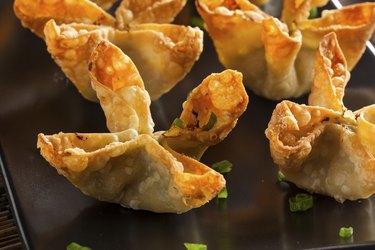
A wonton made with lump meat crab and cream cheese, crab rangoons are deep-fried appetizers commonly served in Chinese American restaurants. According to the Auguste Escoffier School of Culinary Arts, a crab rangoon is not a traditional Chinese appetizer, but one that was created in America.
Crab Rangoon Nutrition Facts
Video of the Day
According to the USDA, a 100-gram serving (about 3.5 ounces) of Target's frozen crab rangoon contains 303 calories. The carbohydrates in crab rangoon clock in at 36.4 grams, with a crab rangoon sugar content of 4.04 grams. This serving also contains 9.09 grams of protein, 1 gram of fiber and 14.1 grams of fat, which contributes approximately 22 percent of the recommended daily dose of fat for an adult diet.
Video of the Day
Similarly, a 100-gram serving of Harris Teeter's frozen crab rangoon contains slightly fewer calories, at 271. This serving also offers 9.41 grams of protein, 14.1 grams of fat and 1.2 grams of fiber. There are also 28.2 grams of fat and 2.35 grams of sugar in this serving.
Read more: Gluten-Free Chinese Foods
One crab rangoon nutrition benefit is its calcium content. A 100-gram serving has between 40 to 47 milligrams of calcium, or approximately 4 percent of the recommended daily dose. According to a November, 2018, review published in Clinical Interventions in Aging, calcium is essential for bone growth, secreting hormones and nerve impulse transmission.
The Downsides of Packaged Food
Both types of frozen crab rangoon mentioned above are high in sodium — a 100-gram serving of the Target brand has 687 milligrams of sodium, while Harris Teeter's is slightly lower, at 447 grams. According to the American Heart Association (AHA), healthy adults should ideally consume no more than 2,300 milligrams of sodium per day.
However, most Americans do not follow the AHA guideline, and instead average approximately 3,400 milligrams of sodium every day. The FDA explains that over 70 percent of dietary sodium comes from eating a diet rich in packaged and fast foods.
Chinese restaurants in the United States have modified Chinese recipes to suit the American palate, and as a result, sometimes offer dishes high in sodium. Too much sodium, however, can lead to cardiovascular diseases and high blood pressure.
Eating too much crab rangoon can also increase the amount of saturated fat in the diet, leading to an increase in cardiovascular issues. A 100-gram serving of crab rangoon has 5.9 grams, or 29 percent of the daily value of saturated fats. The recommendation is that less than 6 percent of daily calories should come from saturated fat — for a 2,000-calorie diet, that equals approximately 13 grams of saturated fat per day.
Limiting the intake of crab rangoon will also restrict saturated fat in the diet. Ideally, replacing saturated fats with unsaturated fats will help with long term health. A July, 2017, study published in Circulation found that replacing saturated fats in the diet with unsaturated ones, like polyunsaturated fats, results in a significant decrease in the incidence of cardiovascular disease.
- Champlain College American Folklore Society: "Review of: From Canton Restaurant to Panda Express: A History of Chinese Food in the United States”
- Auguste Escoffier School of Culinary Arts: "Go Beyond the Egg Rolls With Chinese-American Food"
- USDA FoodData Central: “Crab Rangoon"
- USDA FoodData Central: “Crab Rangoon"
- American Heart Association: “How Much Sodium Should I Eat per Day?"
- Clinical Interventions in Aging: "The Good, the Bad, and the Ugly of Calcium Supplementation: A Review of Calcium Intake on Human Health"
- U.S. Food & Drug Administration: "Use the Nutrition Facts Label to Reduce Your Intake of Sodium in Your Diet"
- USDA: “Nutrition Facts for Crispy Crab Rangoon"
- Circulation: "Dietary Fats and Cardiovascular Disease: A Presidential Advisory From the American Heart Association”
- American Heart Association: "Saturated Fat"